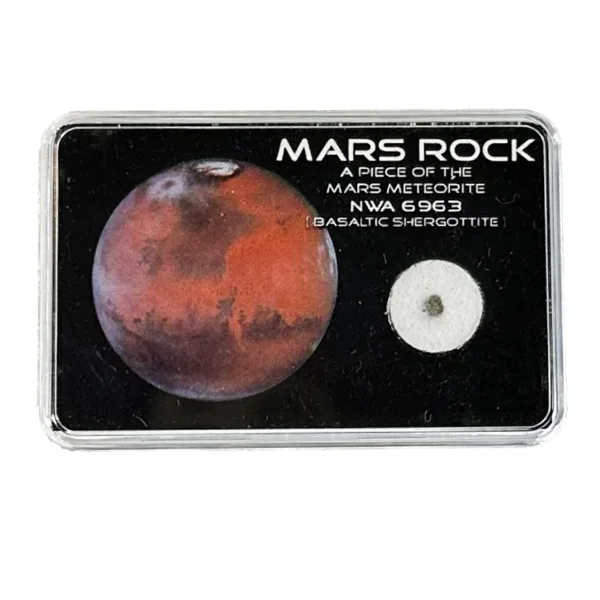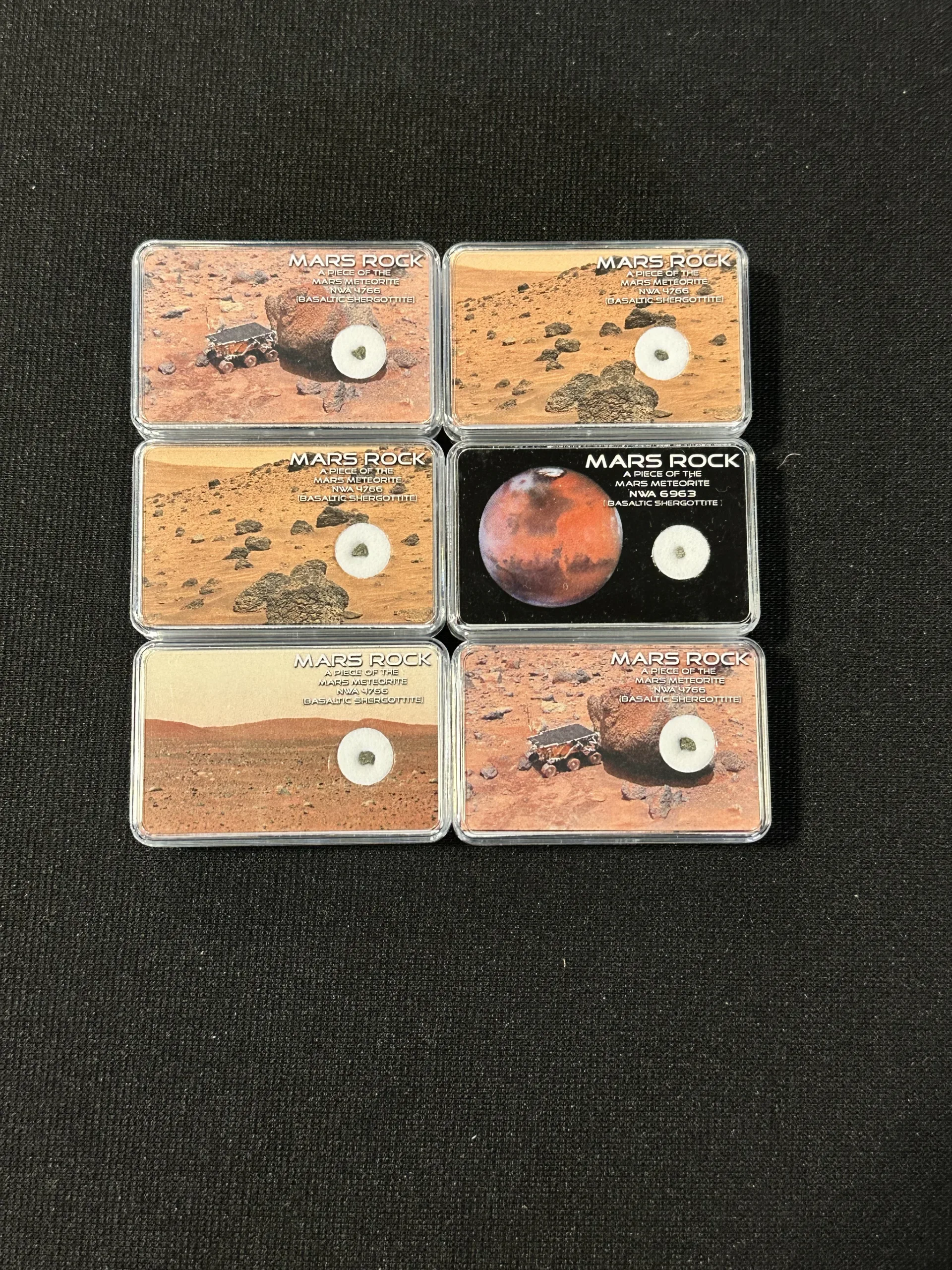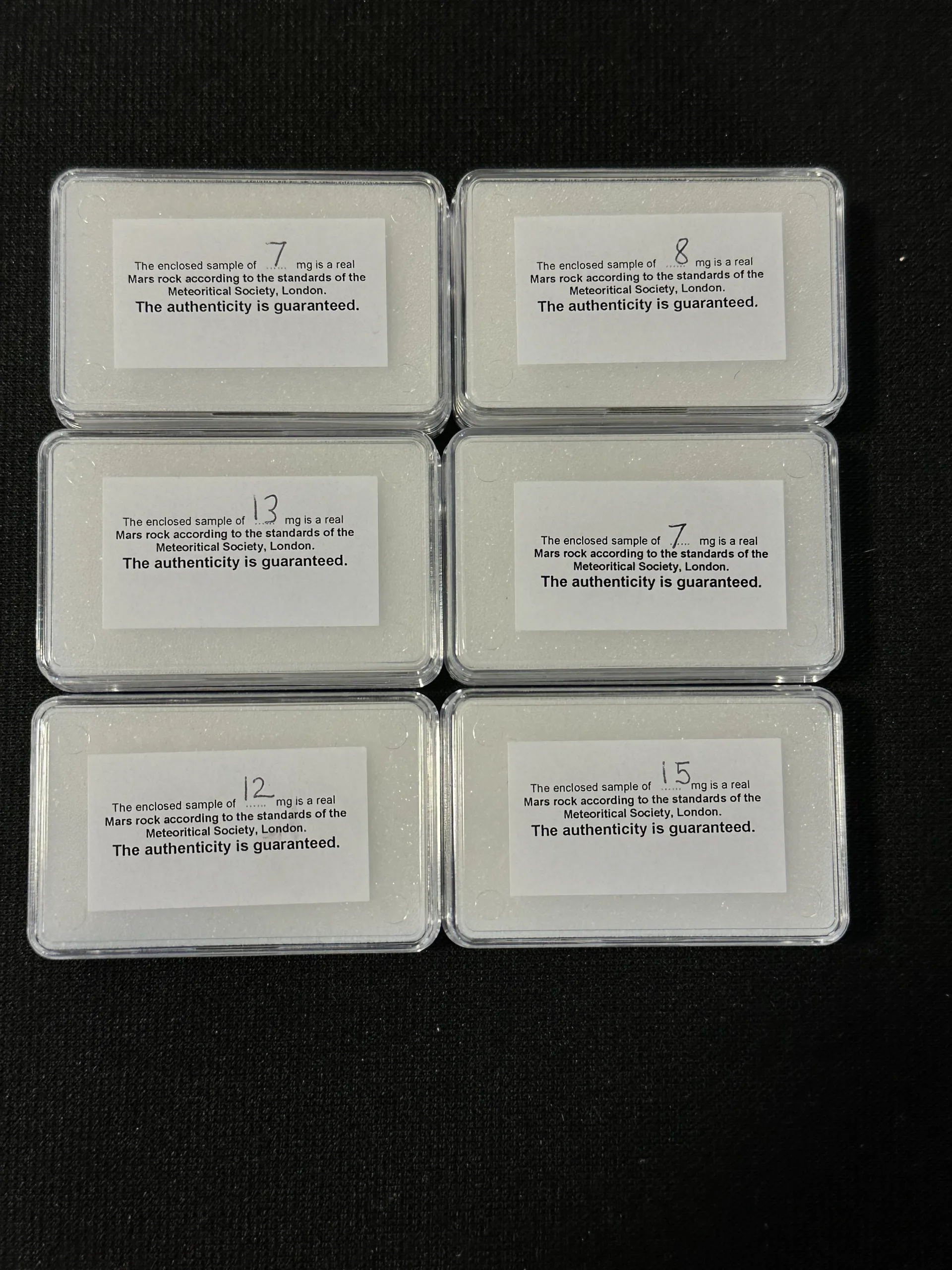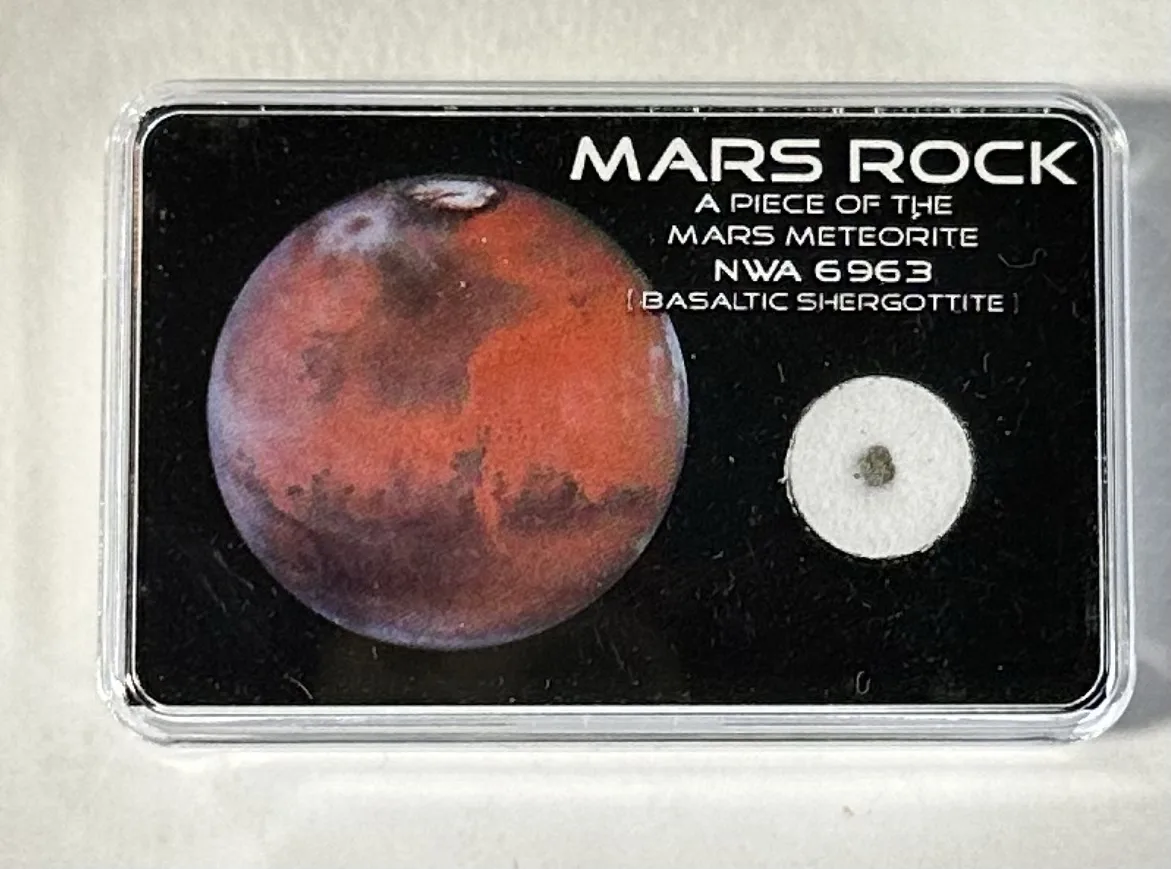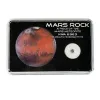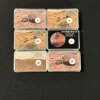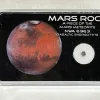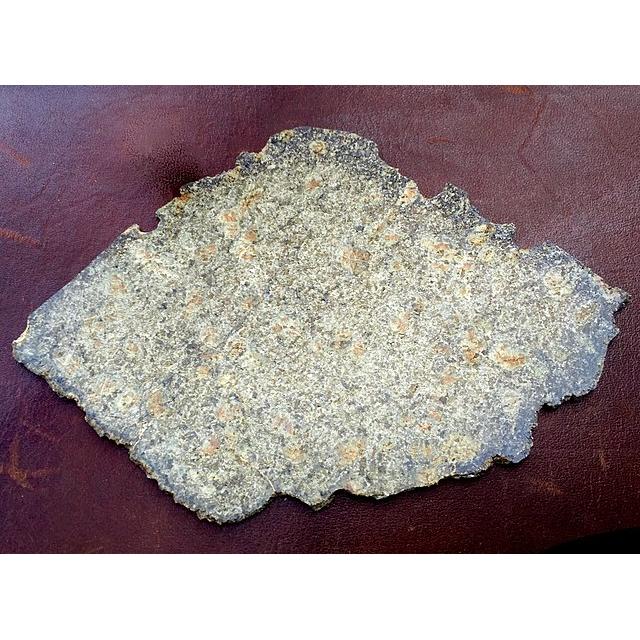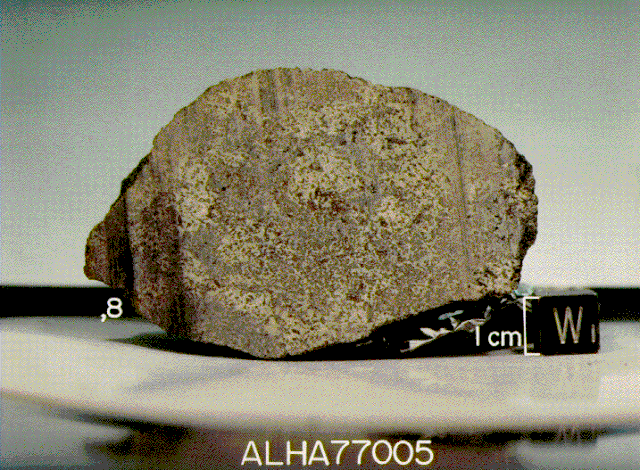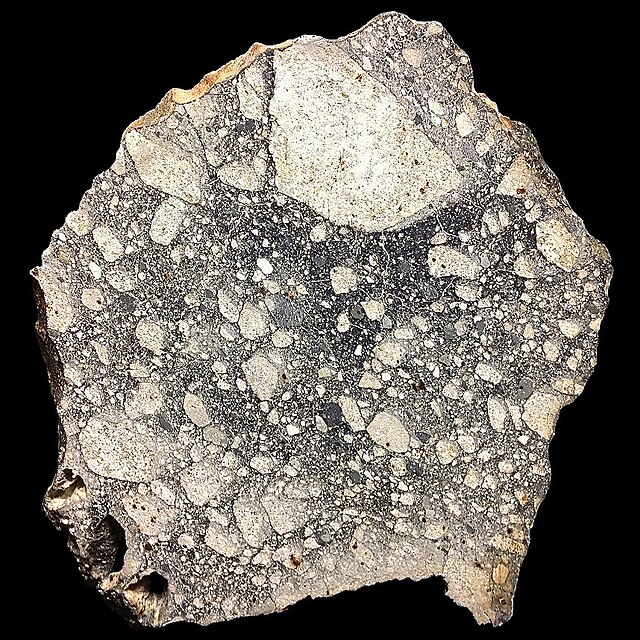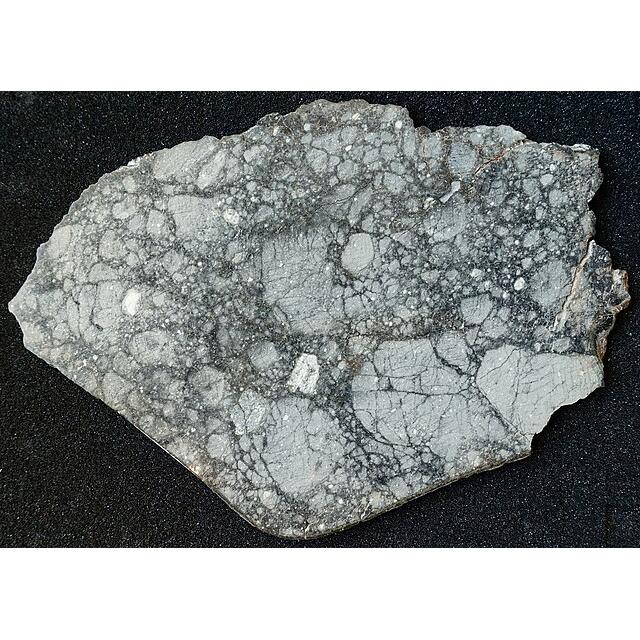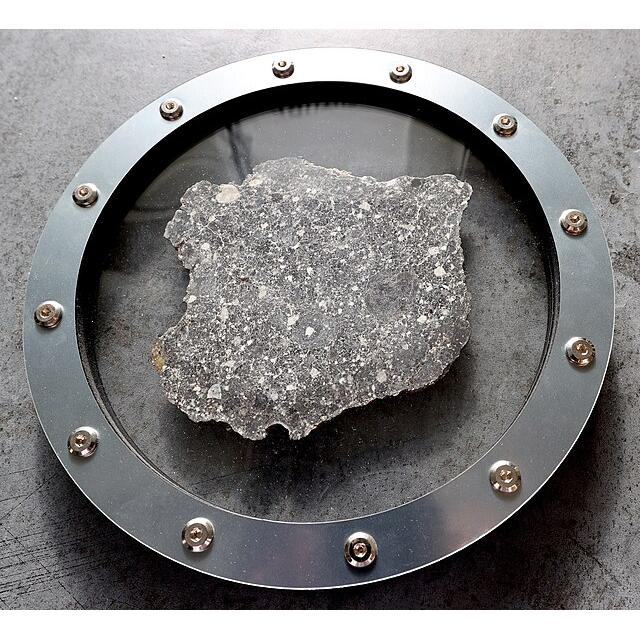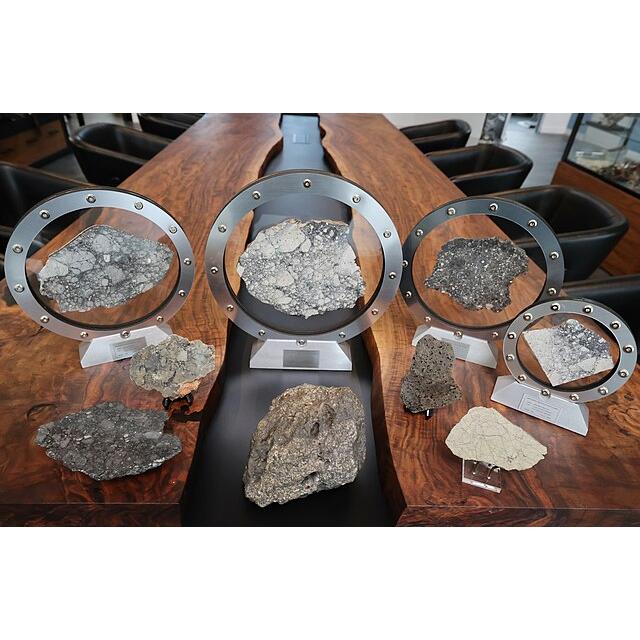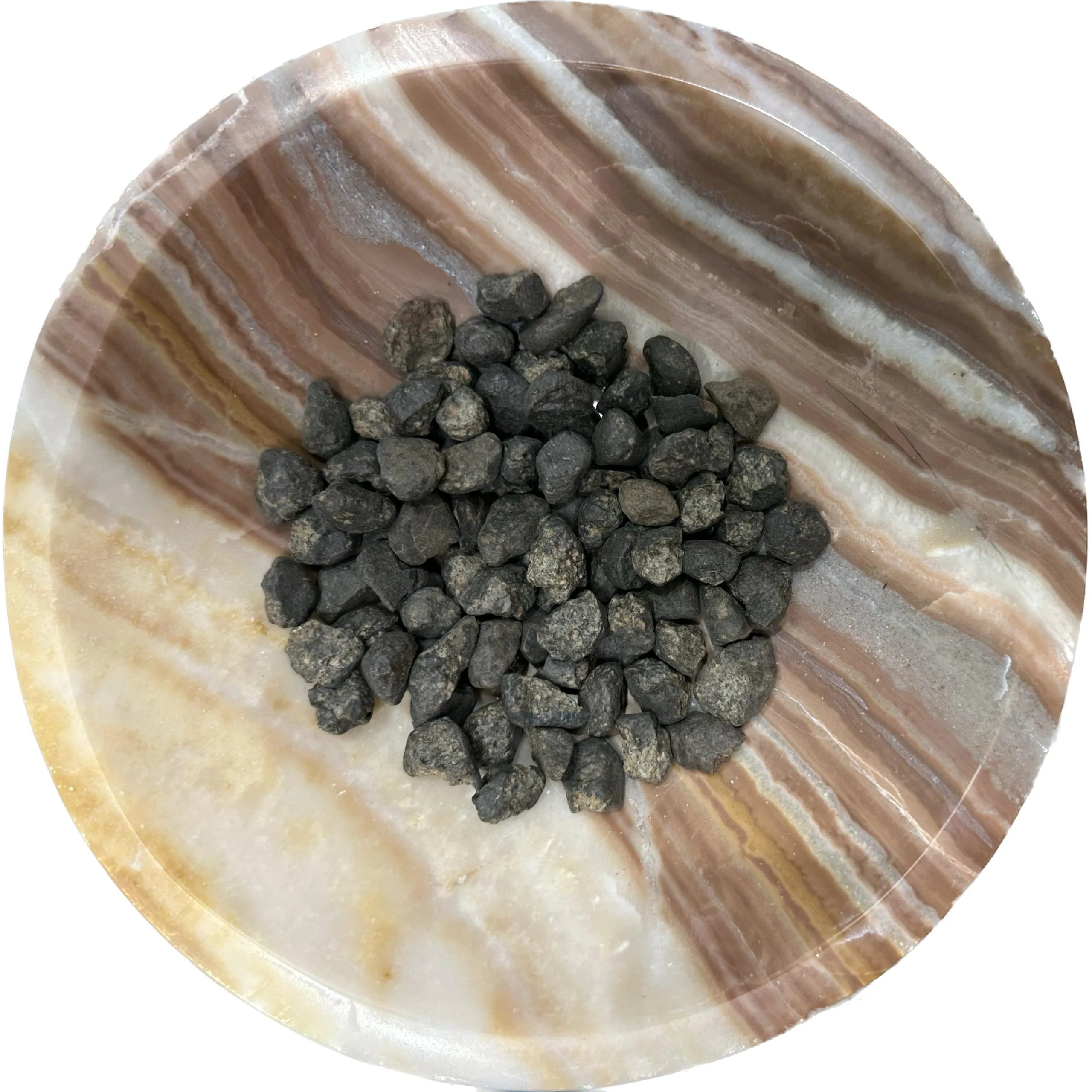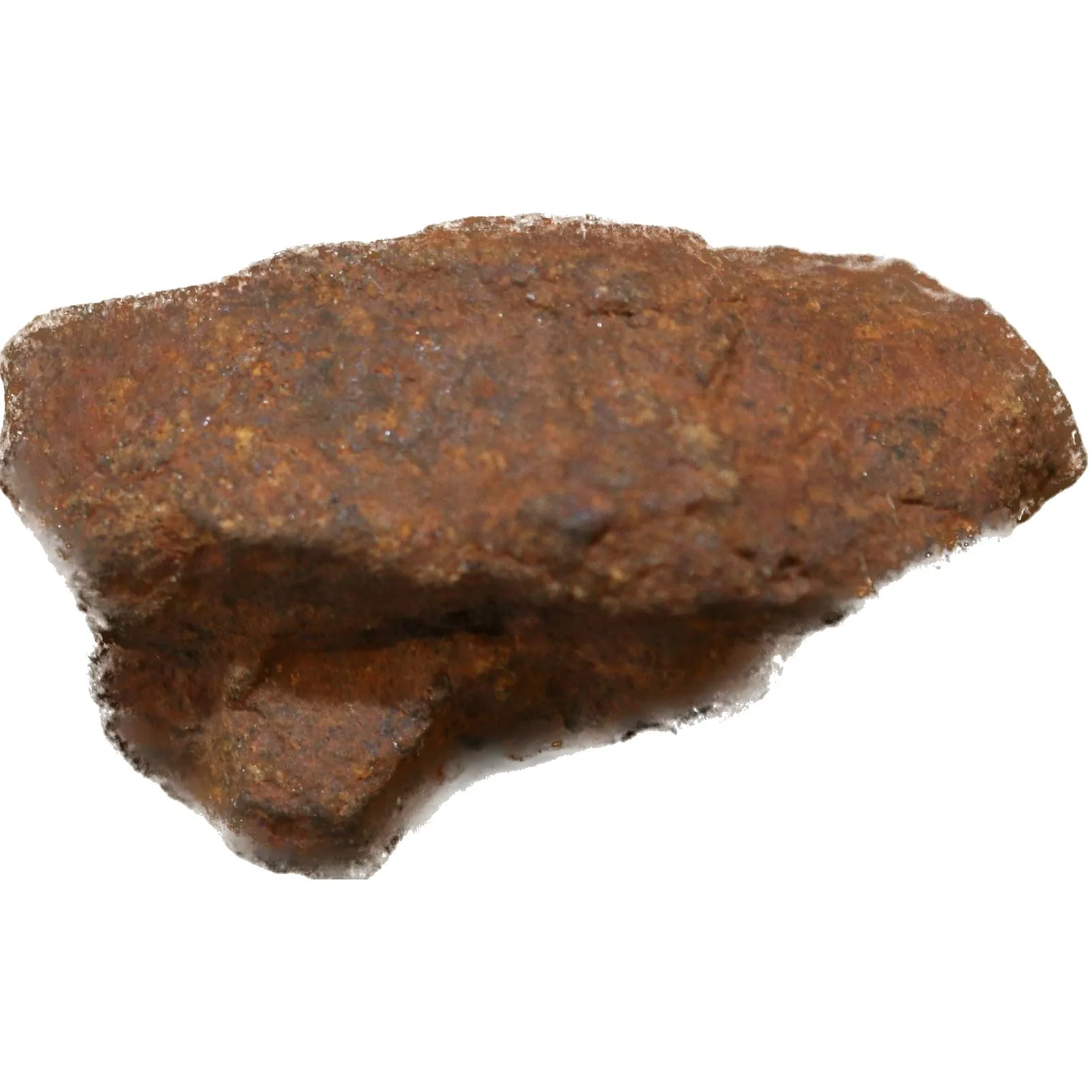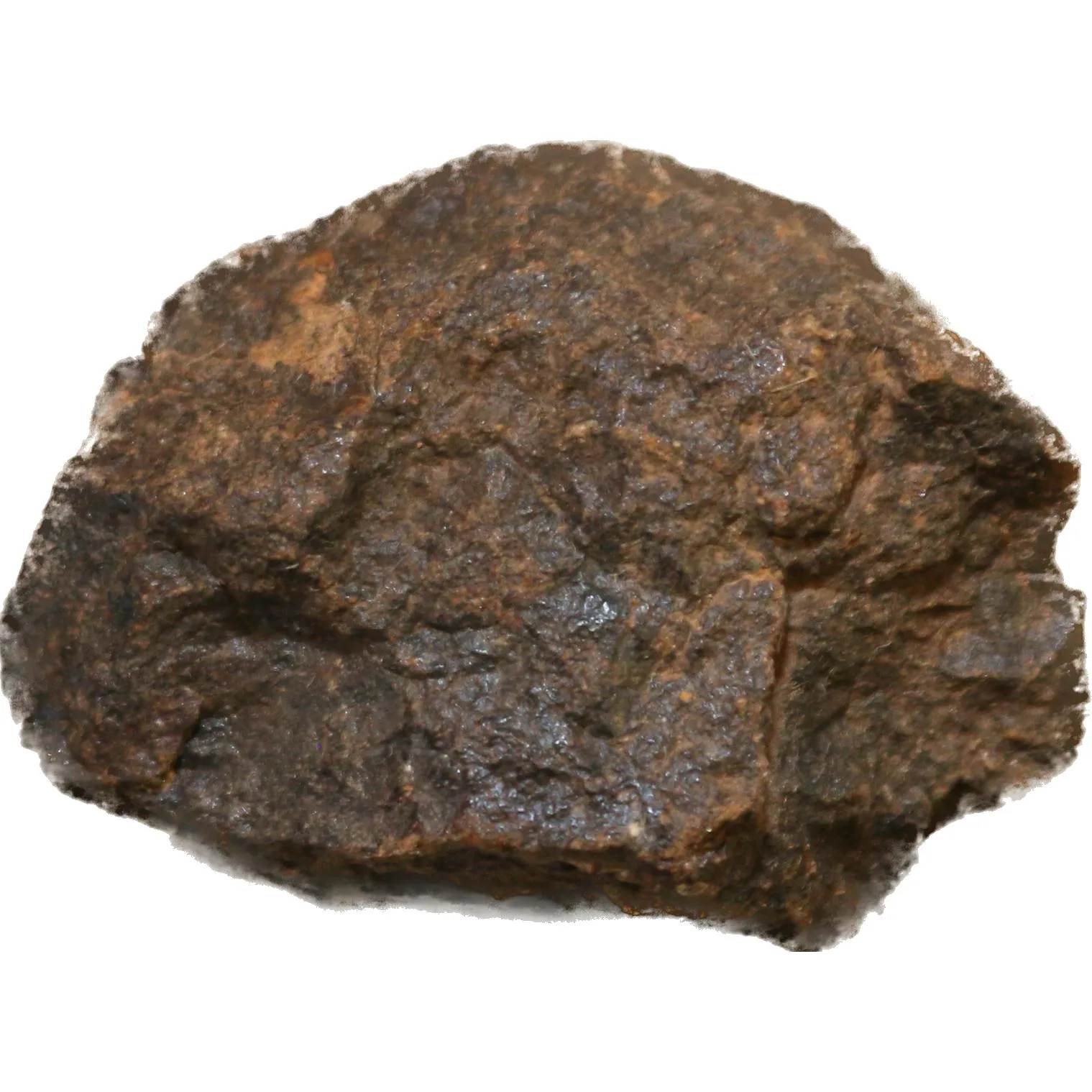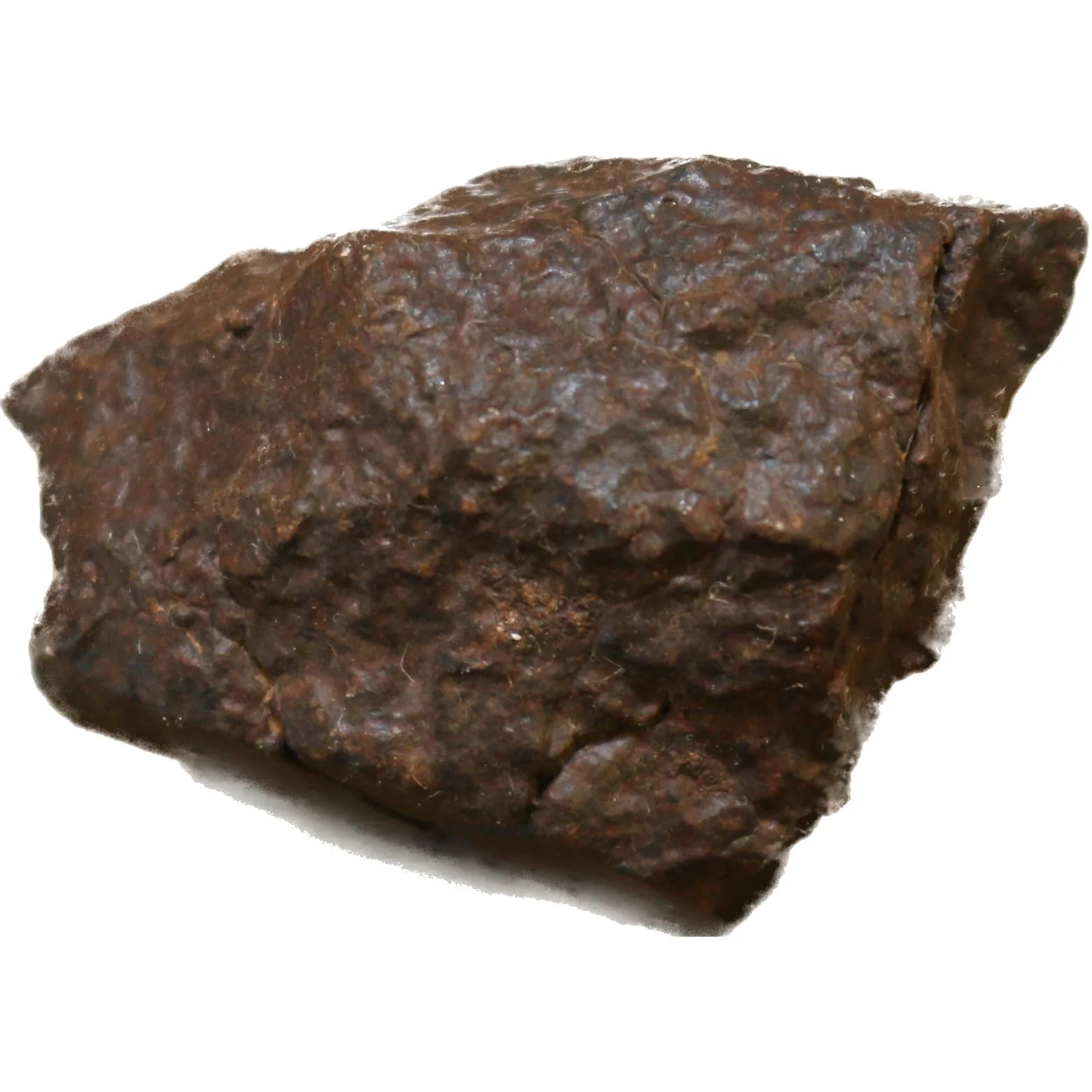Martian Meteorite, NWA 6963
Beautiful imagery makes this a beautiful collectible. Mars rocks are rare and highly sought after.
Martian Meteorites:
Martian meteorites, also known as SNC meteorites (shergottite, nakhlite, and chassignite), are rocks that originated from Mars and found their way to Earth through natural processes. These extraterrestrial specimens provide scientists with invaluable insights into the geology, geochemistry, and potential habitability of the Red Planet. In this exploration, we delve into the fascinating world of Martian meteorites, examining their origins, characteristics, and significance in scientific research.

Origins:
The origins of Martian meteorites are tied to the dynamic geological history of Mars, a planet with a diverse range of surface features, including volcanoes, impact craters, and ancient river channels. These meteorites are thought to originate from specific regions on Mars, such as volcanic plains, impact basins, and the ancient crust. Impact events on Mars can eject rocks and debris into space, some of which intersect with Earth’s orbit and eventually fall to the surface as meteorites.
Characteristics:
In addition to their mineralogy, Martian meteorites often display features indicative of their extraterrestrial origin, such as shock veins, regmaglypts (thumbprint-like depressions), and fusion crusts formed during atmospheric entry. These physical characteristics provide clues about the conditions experienced by the meteorites during their journey through space and entry into Earth’s atmosphere.

Classification:
Martian meteorites are classified into three main groups based on their mineralogical and geochemical characteristics: shergottites, nakhlites, and chassignites.
Shergottites are the most abundant type of Martian meteorite and are primarily composed of basaltic rock. They are thought to originate from volcanic eruptions on Mars and exhibit features such as vesicles (gas bubbles), glassy matrices, and evidence of shock metamorphism caused by impact events.
Nakhlites are a relatively rare type of Martian meteorite characterized by their unique mineralogy, which includes minerals like olivine, augite, and feldspar. They are believed to originate from the Martian crust and are thought to have formed through volcanic processes similar to those on Earth.
Chassignites are a rare group of Martian meteorites composed predominantly of olivine, with minor amounts of other minerals such as pyroxene and chromite. They are thought to represent pieces of the Martian mantle and provide valuable insights into the deep interior of the planet.
Significance:
Martian meteorites are of great significance to scientists for several reasons. Firstly, they provide a direct sampling of the Martian surface, offering insights into the planet’s geological history, surface processes, and potential for past habitability. By studying the mineralogy, geochemistry, and isotopic compositions of Martian meteorites, researchers can infer the conditions under which these rocks formed and the geological events they experienced.

Furthermore, Martian meteorites have implications for the search for life beyond Earth. While none of the Martian meteorites discovered so far have contained direct evidence of past or present life, they provide clues about the potential habitability of Mars and the environments that existed on the planet billions of years ago. Studying Martian meteorites helps scientists identify promising targets for future Mars exploration missions aimed at searching for signs of life.
Research and Exploration:
Scientists use a variety of techniques to analyze Martian meteorites and extract valuable information about the Red Planet. These include petrological studies, geochemical analyses, and isotopic dating methods. By studying the mineralogy, texture, and chemical composition of Martian meteorites, researchers can reconstruct the conditions under which they formed and the processes that influenced their evolution.

In addition to laboratory analyses, researchers conduct field expeditions to recover Martian meteorites from terrestrial locations. Antarctica is a particularly fruitful hunting ground for Martian meteorites due to its pristine ice fields, which preserve extraterrestrial rocks that have fallen to Earth. Other regions, such as deserts and hotspots of meteorite accumulation, also yield significant finds.
Lunar Meteorites (Moon Rock):
Lunar meteorites, also known as lunar meteorites or lunaites, are rocks that originated from the Moon and were ejected from its surface due to impacts. These extraterrestrial rocks offer scientists a rare opportunity to study the composition and history of our nearest celestial neighbor. In this exploration, we delve into the fascinating world of lunar meteorites, examining their origins, characteristics, and significance in scientific research.
Origins:
The origins of lunar meteorites trace back to the Moon’s violent past, marked by numerous impacts from asteroids and comets. When a large celestial body collides with the Moon, it can excavate material from the lunar surface, ejecting rocks and debris into space. Some of these fragments escape the Moon’s gravitational pull and eventually intersect with Earth’s orbit, becoming lunar meteorites.
Characteristics:
Lunar meteorites exhibit distinct characteristics that differentiate them from terrestrial rocks. One notable feature is their composition, which closely resembles that of lunar samples brought back by manned and unmanned missions, such as the Apollo and Luna missions. They typically consist of minerals like plagioclase feldspar, pyroxene, olivine, and ilmenite, which are common constituents of lunar rocks.
Another distinguishing trait is the presence of impact melt breccias. These breccias form when intense impacts on the lunar surface generate heat, melting rocks in the vicinity and fusing them together. As a result, lunar meteorites often contain fragments of different rock types cemented within a matrix of impact melt.
Significance:
Lunar meteorites are invaluable to scientists for several reasons. Firstly, they provide access to lunar material without the need for costly manned missions. While the Apollo and Luna missions returned a substantial amount of lunar rocks, they represent only a small fraction of the Moon’s diverse geology. Lunar meteorites offer a more extensive and varied sampling of the lunar surface, enhancing our understanding of its geological history.

Moreover, lunar meteorites provide insights into the broader field of planetary science. Comparing the compositions of lunar meteorites with those of other planetary bodies helps scientists elucidate the processes that govern the formation and evolution of terrestrial planets and moons. It also contributes to our understanding of the early Solar System and the dynamics of impact cratering.
Classification:
Lunar meteorites are classified into different groups based on their mineralogy, texture, and geochemical signatures. The most common classification scheme divides them into mare basalts, highland breccias, and regolith breccias.
Mare basalts originate from the lunar maria, dark plains formed by ancient volcanic eruptions. These rocks are characterized by their low titanium content and high concentrations of iron and magnesium. They represent solidified lava flows that once covered large areas of the lunar surface.
Highland breccias, on the other hand, are composed of fragmented rocks and mineral clasts cemented together by impact melt. They are prevalent in the lunar highlands, the bright, mountainous regions that comprise the majority of the Moon’s surface. Highland breccias provide insights into the processes of impact cratering and regolith formation.
Regolith breccias consist of loose, fragmented material that has been pulverized by impacts and mixed with impact melt. They represent the lunar regolith, the layer of loose debris covering the Moon’s surface. Regolith breccias contain a mixture of highland and mare components, reflecting the complex geological history of the lunar surface.
Research and Exploration:
Scientists use a variety of techniques to analyze lunar meteorites and extract valuable information about the Moon’s history. These include petrological studies, geochemical analyses, and isotopic dating methods. By studying the mineral assemblages, texture, and chemical composition of lunar meteorites, researchers can reconstruct the conditions under which they formed and the processes that influenced their evolution.
Prehistoric 101 (Learn about fossils, minerals, and meteorites)
What is a Meteorite
The Meteoritical Society Database

